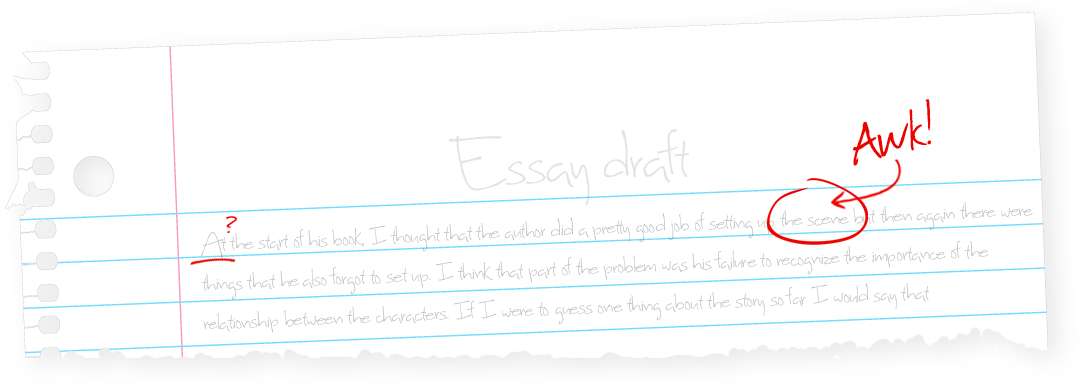This short module examines the power of feedback and revision to facilitate learning. We will cover what feedback is (and isn’t) and what makes for good revision (and what doesn’t). We will also provide resources that can help you learn to become a better teacher of feedback and revision.
Eli Review is particularly powerful in the hands of a good writing workshop teacher capable of using feedback and facilitating revision. This module can help you grow your art as a writing teacher.
Feedback is essential to learning. Helpful feedback is one of the strongest influences on achievement.
“Feedback” is information about how we are doing in our efforts to reach a goal. Feedback, however, is not the same thing as simply responding to students in positive or negative ways. As Hattie and Timperley write, studies that demonstrated the most impact on student learning involved students receiving information about a task and how to do it more effectively. Much lower impacts were related to praise, rewards, and punishment--forms of response that don’t have the characteristics and focus of feedback.
 A common yet unhelpful marginal response
A common yet unhelpful marginal response
Research tells us what feedback must be to be effective:
Feedback is a form of response focused on helping someone meet a goal--to understand something more fully, to perform more effectively.
Teaching and learning don’t happen in a vacuum. They happen within specific schools, classrooms, and cultural contexts. This is true for feedback as well.
Effective feedback requires a context in which learners have both the ability and opportunity to hear, understand, and act on that feedback. We might think about feedback rich classrooms as “safe and smart” learning contexts, or classroom communities in which students feel comfortable enough to risk engaging and learning with each other.
"If students know the classroom is a safe place to make mistakes, they are more likely to use feedback for learning." - Dylan William
The power of feedback is its value in facilitating revision, such as revising an essay or revising one’s understanding of a concept. Revision is one of the key differences between expert and inexpert writers. Expert writers revise. Beginning and inexpert writers don’t revise much. Or at all.
Research shows that routinely engaging in revision is associated with better writing performance. Students who were required to routinely revise scored highest on the National Association of Educational Progress. Those who were never asked to revise scored poorly.
 Student responses are often focused on surface-level changes, which isn’t really feedback
Student responses are often focused on surface-level changes, which isn’t really feedback
30 years of research by composition scholars tells us that we should be helping students learn to revise and to do so via multiple drafts or iterations. However, Jody Shipka notes something essential with regard to revision: surface changes--what lots of teachers call “editing” and “peer editing”--is not “revision” (just as “peer editing” is not the same thing as “peer feedback”). Like other researchers interested in revision, Shipka focuses on “deep revision,” or a process that involves rethinking the purpose, goals, audiences, and ideas of writing.
In the same way that we must specifically define feedback, so too must we define revision so that it can facilitate learning and improved writing:
Revision involves re-visioning a learning task with the willingness to make substantial changes.
In Part 1, we noted that feedback is something very specific and that it’s more than simply “responding” to students. “Feedback” is information about how we are doing in our efforts to reach a goal. We know that inexperienced reviewers often give unhelpful feedback (“I like it”). Teachers are sometimes no better. How helpful is it when we write “awk” in the margin of a student paper?
Both teachers and students need to get better at providing feedback, but quality feedback between peers has the potential to transform our teaching. As Peter Johnston writes, most of the feedback students receive comes from their peers, and so:
We have to remember that we are not just giving students feedback [as teachers]; we are also teaching them to provide it. In a way, we are teaching them to teach. If students can provide productive feedback, then collectively they will tend to get more feedback. And it will be more immediate feedback, because, rather than waiting for the teacher, their peers can provide it. More feedback improves learning, and immediate feedback is more effective than delayed feedback. Increasing the responsiveness of the classroom by actively teaching students how to respond to each other’s efforts magnifies the effects of our teaching.
More feedback improves learning. The good news is that we can all provide each other with effective feedback, and we can all learn to get better at it. Feedback can be taught and learned.
So what, then, are the qualities of helpful feedback?
As teachers, our goal should be to prepare students to give feedback that helps a writer understand:
Of course, we help our students when our own feedback has these characteristics. But how can we help our students learn to provide better feedback? Three specific things we can do include:
But once students have the basics of giving helpful feedback, how do we help them use feedback they receive?
Too frequently, writers don’t revise or they fail to engage in high-quality revisions (e.g., deep revision). Therefore, it is necessary to move beyond simply asking students to revise. We must teach revision.
One approach to teaching revision is to teach revision planning. The idea behind revision planning is to ask students to think and reflect on their writing and feedback and to do so in a way that allows teachers (and peers) to see that thinking. If we can see each other’s thinking (planning in this case), then it is possible to provide additional feedback (or make other interventions). Asking students to create a plan for their revision is also the best way to move students toward actually revising.
The student chooses specific feedback to use.

The student orders feedback from most important to least important.



The student reflects on feedback and revises.

Revision planning entails three meta-cognitive moves that lead to improvement:
Supporting and practicing this meta-cognitive work is necessary to ensure revision and learning. Eli Review, for example, includes a set of revision tools designed specifically to help students select helpful feedback, create prioritized lists, and reflect on their plans.
Although the universal teacher lament that there’s no time for such feedback is understandable, remember that “no time to give and use feedback” actually means “no time to cause learning” - Grant Wiggins
Teachers at every level face the pressures of coverage, pacing guides, or standardized assessments that make even the most experienced teachers wonder how they can fit more feedback and revision into a packed calendar. However, 30 years of research into learning and writing is conclusive:
"As we have seen, research shows that less teaching plus more feedback is the key to achieving greater learning. And there are numerous ways—through technology, peers, and other teachers—that students can get the feedback they need." Grant Wiggins
One of the challenges to making space for more feedback is how time is allocated in many writing assignments:

Typically, the majority of time in an assignment sequence is spent on writing and discussion, leaving less time for feedback and revision. As we've seen, however, revision is where learning happens, so an assignment sequence designed to facilitate those learning moments should spend the majority of its time there.
One way to make space in curriculum for more feedback and revision is to change assignment sequencing. If we were to roll out the "typical" donut above, this is what an assignment sequence might look like:

In sequences like this, a lot of time is invested developing a fully-functional version of a text. Some consequences of this sequence include:
Contrast the typical writing-intensive sequence to a workflow like this, where the mantra is "review early and review often":

Here, in the same amount of time, review and revision are treated as co-equal components and more closely resemble the iterative process writing studies has advocated for 30 years.
There are numerous advantages to a more iterative writing process:
There are other ways to make room for the teaching and coaching of feedback and revision, particularly in the way that reviews are designed and results are reported.
This module has made the case for why writing instruction focused on feedback and revision stands a better chance of producing not just better writing but also better writers.
Explore additional entries in this four-part Teacher Development Series to take these ideas further, or find examples of Eli Review in action and how to use it effectively.
Looking for ways to build a classroom culture rich in feedback and revision? We have activities and readings that can help you set students’ expectations and get everyone off to a helpful start:
Curriculum materials and activities:
Reading materials for students:
These materials are licensed under a Creative Commons Attribution-NonCommercial 4.0 International License. This means you are free to copy and redistribute them in any medium or format and to remix, transform, and build upon the material, as long as you provide proper attribution to the authors (Eli Review, or Michael McLeod, Bill Hart-Davidson, and Jeff Grabill). Commercial use of this content is prohibited.